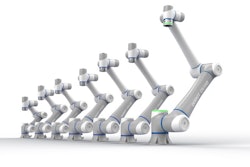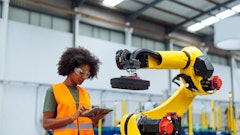
The robots have arrived and are now populating distribution centers, but we are far from realizing full automation. Though 80% of today’s warehouses do not have any automation technology, it's not expected to remain that way. By 2030, worldwide robotics and automation technology adoption is projected to reach 85% of warehouses. Given its inevitable growth, now is the time to consider technologies that will enable companies to thrive in the years to come, while keeping pace with competition and customer demands.
As robotics and automation technology adoption increases, Robots as a Service (RaaS) models and improving supply chain visibility are becoming more prominent. Additionally, we're witnessing companies leverage the value of people in operations, as robots are deployed for simple tasks to make way for new employee career growth.
1. RaaS is Gaining Popularity
In 2018, ABI Research reported that yearly revenue from RaaS providers would increase from $217 million in 2016 to $34 billion in 2026. Now, as labor continues to be a challenge for many, RaaS-based automation is certainly gaining traction. The driving force behind its popularity lies in the benefit of lowering capital expenditures and deploying automation based on subscription – an attractive way for companies seeking immediate solutions without significant up-front investment. In particular, autonomous mobile robots (AMRs) and piece-picking solutions are among the most popular. As technology advances, the breadth of robotic solutions being deployed in this way will surely increase, signaling that it is time for companies to consider how this model may work in their business plans now and in the future.
The added bonus of the RaaS model is it enables companies to fill labor gaps, especially during times of heightened demand, such as the holiday season, while also providing support for less-desirable work shifts during a tight economy.
2. Supply Chain Visibility is Needed
A major pain point for smaller, independent retailers is the lack of visibility into their warehouse operations. While the largest retailers know the SKU assortments they will offer in stores and thus be better able to manage supply chains specific to store locations, smaller retailers are left without the ability to have insight into their entire supply chains. This can be a major problem that causes friction for operations and, ultimately, impacts product delivery to customers who have grown accustomed to next-day and even same-day delivery.
Because of this, interest and investment are rising toward solutions that will provide better insight into what's taking place in distribution centers. Specifically, companies are looking at a combination of technologies to achieve this, such as 5G platforms that enable interoperability across different subsystems.
3. People Play a Critical Role in Automation
Although a common misconception is that humans will be replaced by machines, the market has realized that automation without people is truly difficult – there are numerous tasks that a robot cannot perform nearly as well as human labor. People are one of the best ways to ensure operations continue to move smoothly, while robots are optimized to perform mundane and repetitive tasks in distribution centers. The result is that companies can shift their employees to positions where it's not possible for robots to be integrated or as robot supervisors. That can open the door for employee growth and development, since workers can expand their focus to more value-add areas.
This goes hand-in-hand with another trend related to inventory density in warehouses. As we enter a post-COVID world, fulfillment operations are beginning to move away from a "just in time" inventory to expanding capacity for more products.
As this unfolds, inventory is being shifted out of retail stores and into other locations, such as micro-fulfillment centers. This means that distribution centers need to think strategically about how to utilize existing space and if it makes sense to invest in technology that will allow them to capitalize on current assets.
Automation technology is here to stay, but many companies have only seen the tip of the iceberg. As adoption of robotics and warehouse automation technologies accelerates worldwide, there is no time for organizations to wait if they intend to keep pace with the competition. It will be interesting to observe how these trends impact business operations in 2023 and beyond.




![Pros To Know 2026 [color]](https://img.sdcexec.com/mindful/acbm/workspaces/default/uploads/2025/08/prostoknow-2026-color.mduFvhpgMk.png?auto=format%2Ccompress&bg=fff&fill-color=fff&fit=fill&h=100&q=70&w=100)







![Pros To Know 2026 [color]](https://img.sdcexec.com/mindful/acbm/workspaces/default/uploads/2025/08/prostoknow-2026-color.mduFvhpgMk.png?ar=16%3A9&auto=format%2Ccompress&bg=fff&fill-color=fff&fit=fill&h=135&q=70&w=240)




![Top Tech Startup Logo 2025 Vertical [color] (1)](https://img.sdcexec.com/mindful/acbm/workspaces/default/uploads/2025/07/top-tech-startup-logo-2025-vertical-color-1.pZkBK95TLe.png?ar=16%3A9&auto=format%2Ccompress&bg=fff&fill-color=fff&fit=fill&h=135&q=70&w=240)


